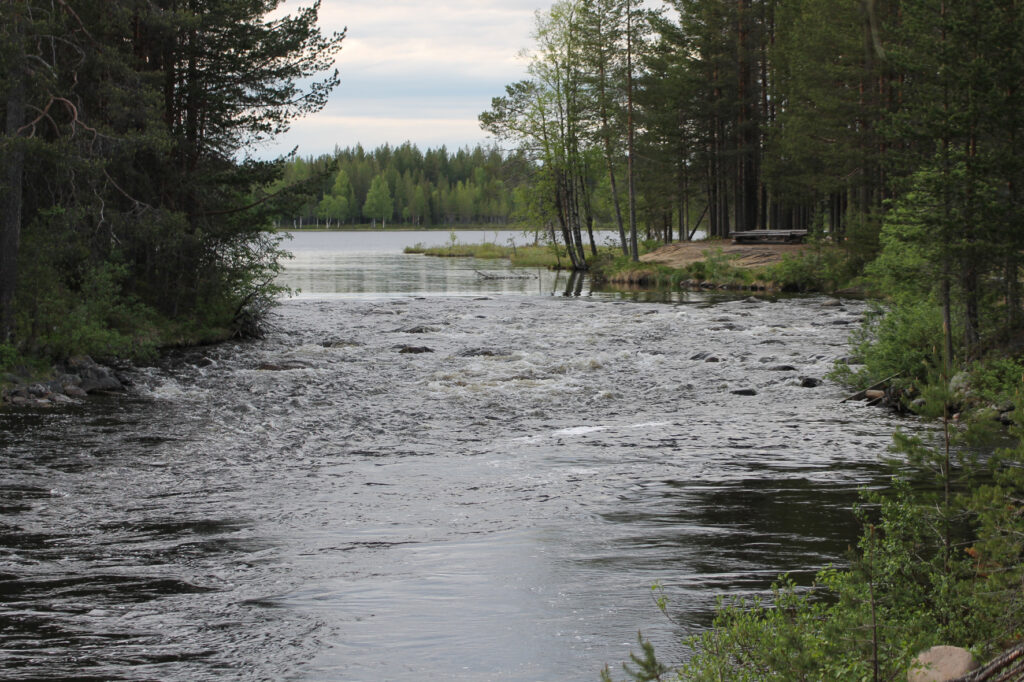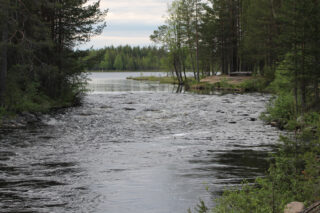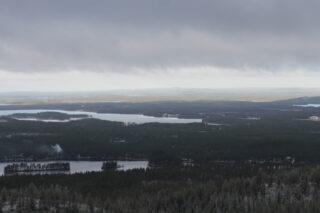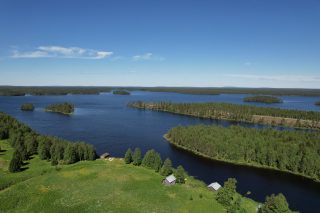Piikstammi
Piikstammi is a short but bountiful gate between the lakes Muojärvi and Joukamojärvi, where fish can easily swim in both directions. Piikstammi’s channel was once used to lower the water level of Lake Kuusamojärvi, so at Piikstammi the current drops by more than a meter in a distance of 75 meters. Piikstammi is a unique and atmospheric excursion destination for the whole family.
Piikstammi’s fishing area is a little less than half a kilometre long, the upper part flows slowly and calmly, then speeds up imperceptibly, and downstream there is a hundred-meter-long rocky rapid. Multikoski is clear as a fishing spot, approx. 150 meters long, and has a fast current almost the entire way.
From the Kuusamo town centre, from the shore of Lake Kuusamojärvi, you can reach Lake Muojärvi via waterways, from there on to Lake Piiksinlampi and via the Piikstammi boat launch to Lake Joukamojärvi, from where you can go up the River Muojoki to Lake Muojärvi and back to Lake Kuusamojärvi. The distance to this water route is about 90 kilometres.
Iivaara
The precious old forests of Iivaara are northern forest hill nature at its best. The Iivaara-Jousivaara conservation area, located in Southern Kuusamo, consists of two forest covered hill sub-areas: Iivaara-Penikkavaara and Laihanvaara-Jousivaara, as well as the groves and swamps conservation areas connected to them. The Laihanvaara area is associated with the valuable Virmajoki flood meadow as a traditional landscape.
Iivaara is a wilderness hiking destination with an outdoor trail running through it. Thanks to the abundance of decaying trees on the hill, Iivaara is also well-known among bird watchers.
Read about Midsummer in Iivaara
Isosuo
The Lämsänkylä’s River Syväjoki, which is freed from the ice early, is a favourite dining and resting place for swans, geese, and other waterfowl in early spring. On the north side of the river, there is a large marsh, Isosuo, which is one of the best bird marshes in Southern Kuusamo.
The middle part of the marsh with its open water rim is its wateriest part, where the seagulls have settled and all the long-winged birds that occur at the altitude of Kuusamo regularly nest there.
In Isosuo, almost all species of waders that regularly nest in Kuusamo are represented, starting with the common crane. The rarest representatives include the red-necked phalarope, the broad-billed sandpiper, and the jack snipe. Of these, the latter two species are at the top of the wish list of bird tourists traveling to Kuusamo.
Kassanajoki
The names of the Joukamojärvi area, beaches and islands tell of Kuusamo’s Sámi times and connections to Karelia, lively trade, and interactions. In the area you can find e.g., Nastonsaari, Ontreinsaari, Karjalanhauta and Riionlahti. A White Sea Karelian merchant named Kassana from Tuhkala regularly sold butter and other food products at the market in Kantoniemi. The trip went along the river Pistojoki watercourse via lakes Joukamojärvi and Muojärvi to Lake Kuusamojärvi. It is said that Kassana got tired of pulling his boat across the isthmus between Lake Vuolajärvi and Lake Joukamojärvi and dug a ditch in it, along which the boat travelled more easily. Over time, a river grew out of that ditch, to which Kassana left his name. Kassananvaara and Kassananlampi are also located in the area.
Näätämutka
There is nowhere in Kuusamo as far from the road as standing at the tip of Näätämutka. At that point, the Russian border comes across when travelling to the east, south and west.
At the end of Lämsänkyläntie, behind Tammela and Mattila, the national border makes a bend resembling a parrot’s beak at Näätämäisenjärvi, Näätämutka, the area of Virmajoki, which is the last few real wildernesses of Kuusamo. The Virmajoki area is 3 234 hectares in size and is among Finland’s best old-growth forest conservation sites. It is the region of experienced hikers and hunter-gatherers.
The Virmajoki area is rhythmically marked by a pattern of drumlin-ridged ponds running from northwest to southeast. You can move in the area without a compass because the Ice Age shaped each ridge to follow exactly the same line.
Kuusamo’s most wonderful old slash-and-burn areas are located in the region, for example Puuroaho on the west side of Lake Hanhilampi, which is a 120-year-old forest born after slash-and-burn farming.
The stones of St. Peter
There are three large stones in Lake Joukamojärvi (65° 50.4401″N, 30° 00.7733″E). According to the story, after creating the world, St. Peter had noticed that three stones had been left in the wrong place. So, he lifted them onto his back to carry them with straps made of paper.
However, it rained during the trip, the paper straps got wet and broke. That is why the stones still remain in where St. Peter dropped them.



